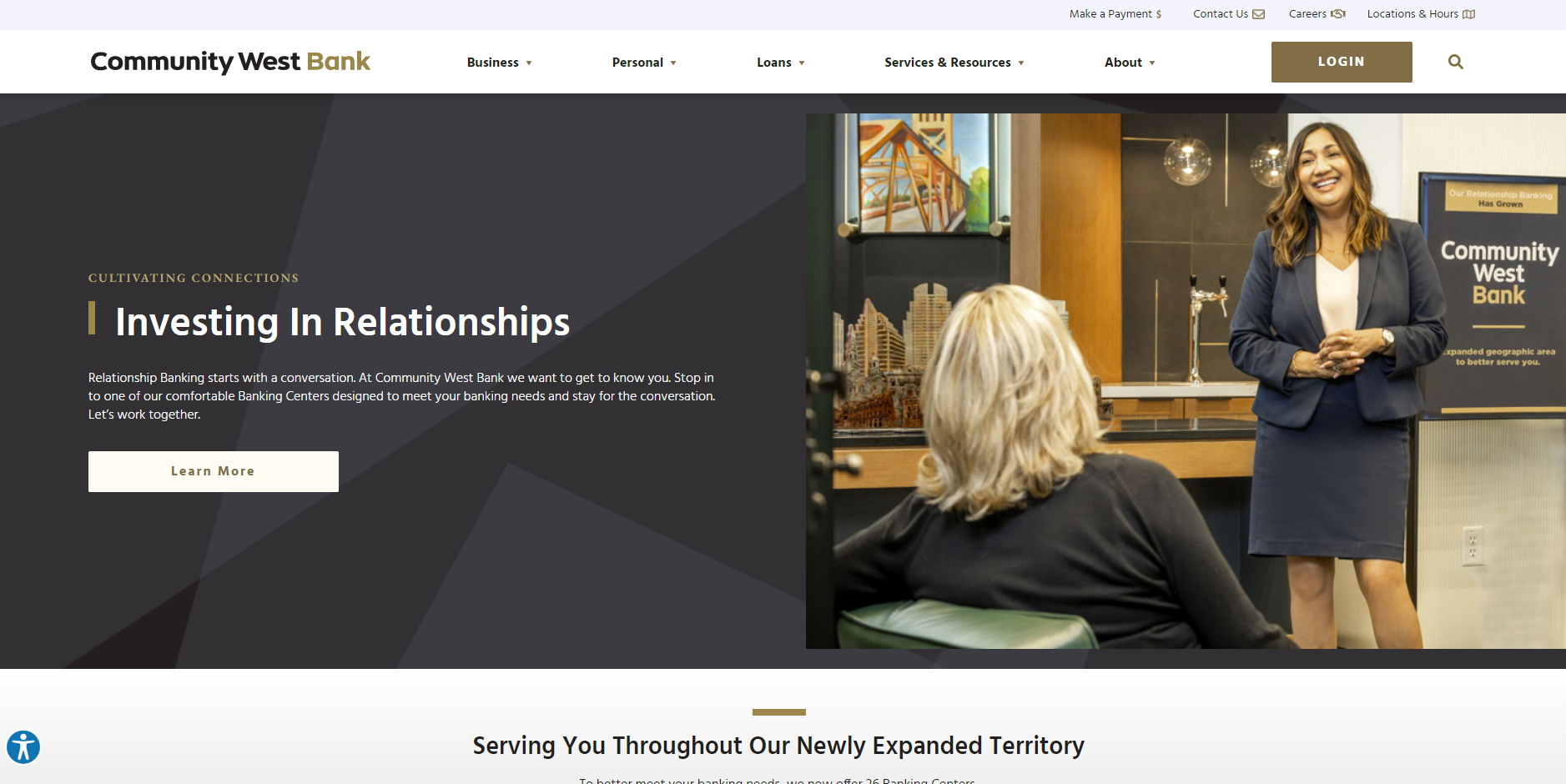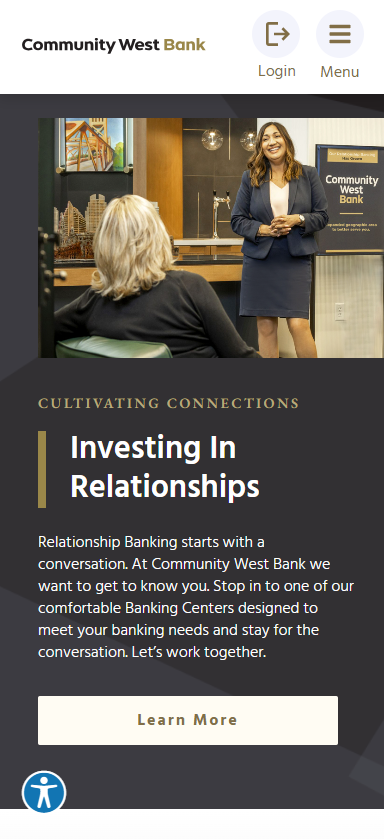Community West Bank
Services we provide:
- Discovery
- Strategy
- UX/UI design
- Website development
- Xperience by Kentico implementation
About Community West Bank
CWB is a large community bank in southern California with over 20+ locations and a track record of financial strength, security and stability gained over its 44 years in business. CWB has set itself apart from other banks by its people, dedication to client advocacy, exemplary "relationship banking," strong community support and a mission to exceed expectations. With a passion for providing customized solutions, the merger drove the decision to revamp their digital services to better serve their customers.
The Process
In an era where digital presence is critical to financial institutions and mergers are frequent, the successful merger of Community West Bank (CWB) and Central Valley Bank (CVB) depended on a robust and well-executed digital strategy, critical to providing a seamless user experience for customers and employees. SilverTech, leveraging its expertise in Xperience by Kentico website development, customized a digital solution that unified the brands of these two banks into one cohesive user-friendly digital experience in just 4 months from start to launch.
The Challenges
The merger of CWB and CVB presented unique challenges, particularly in integrating two distinct digital landscapes into a single cohesive website. The biggest challenges included:
- Differing Content Strategies: CWB's site was optimized for SEO with a rich content library, while CVB's site focused more on detailed product pages. Balancing these different content approaches was crucial.
- Short Timeline: The project needed to be completed with a demanding timeline, delivering a high-quality, functional website, from planning to launch in less than four months.
- Outdated Technology: The old CWB site suffered from poor mobile optimization, slow speeds, outdated information, and a lack of interactive features. This hindered customer engagement and usability.
Goals for New Site
SilverTech identified four main goals for CWB's new website with the main goal of unifying the brands. The merger of the two banks presented a unique opportunity to take advantage of the best from both brands.
Solution and Implementation
Based on the insight gained, SilverTech devised a comprehensive strategy roadmap to address the challenges and deliver a seamless digital experience for the bank merger. It was SilverTech's recommendation that Kentico's newest hybrid CMS platform Xperience by Kentico would be the best solution for the new website. Xperience with robust features and functionality allowed SilverTech to create an exceptional digital user experience efficiently for CWB.
The Key components of the solution include:
- Unified Content Strategy: SilverTech developed a content migration plan that combined the SEO-rich content from CWB with the detailed product information from CVB. This approach ensured that the new site would benefit from both banks' strengths while avoiding duplication and inconsistencies.
- Modern Design and Functionality: The new website was built with Xperience by Kentico, featuring a modern, responsive design to enhance user experience across all devices. Key features included:
- Enhanced Interactivity: Interactive elements and engaging content to improve customer interaction and retention
- Improved CTAs: Clear, strategically placed CTAs to guide users through the site effectively
- Technical Upgrades: Faster loading speeds, improved reliability, and mobile optimization to ensure a smooth user experience
- New Functionalities: Inclusion of essential tools like product comparison tools, branch locator and more
- Accelerated Development Timeline: Despite the tight timeline, SilverTech employed agile development practices to ensure timely delivery without compromising quality. The team worked in sprints to continuously test and refine the site, leading up to a successful launch within the four-month timeframe.
HIGHLIGHTS
Why Your Complex Content Management Solution Could Be Holding Back Your Digital Transformation
4/23/25
When it comes to selecting a content management system, there’s a common instinct to lean toward the industry giants that appear in the top right corner of analyst quadrants. These platforms are often seen as the safest, most validated options, especially for mid-market to enterprise organizations. But while they may look like a reliable choice on paper, they come with significant costs that go far beyond licensing — and those costs deserve closer examination.
Many of these enterprise CMS platforms carry licensing fees well into six figures annually. That’s just to access the platform itself, before creating any content, building workflows, or connecting the system to other parts of your marketing stack. What’s often overlooked is that mid-market CMS platforms, which are substantially more cost-effective, now offer a feature set that covers the same core needs of complex organizations. Multi-site management, multi-language capabilities, advanced personalization, AI-driven insights, workflow automation, integrations with CRMs and marketing tools, and scalable architectures — all of these are available without the need for a six-figure spend. And, all of these solutions would scale to meet the needs of an enterprise business - so while they fit mid-market, they also scale up nicely to enterprise.
The Opportunity Cost of Overspending on Licensing
The argument isn’t just about licensing fees, though. It’s about total cost of ownership and the opportunity cost of tying up budget in technology that, while powerful, may not actually advance the organization’s goals any faster than more affordable alternatives. When that budget is freed up, it can be redirected toward initiatives that have a more direct impact on growth and maturity. Rather than spending heavily just to maintain access to a platform, companies could invest those resources into improving content strategy, expanding personalization efforts, enhancing data analytics capabilities, or even running more aggressive acquisition campaigns.
The Hidden Costs of Some Enterprise Platforms
What complicates matters further are the hidden costs that often come with some large enterprise platforms. These aren’t always immediately visible during the selection process but can quickly accumulate once the platform is in use. Here’s a closer look at where these hidden costs tend to surface:
Hidden Cost | Description | Impact |
Specialized Staffing | Enterprise platforms typically require dedicated, highly specialized technical teams. | Increases operational overhead and complicates hiring and retention. |
Vendor Lock-In | Migration away from these platforms is time-consuming and costly. | Limits future flexibility and locks budgets into ongoing, escalating renewals. |
Complexity Tax | Overly complex systems slow down marketing and content teams. | Reduces agility and delays time-to-market for campaigns and updates. |
Maintenance & Upgrades | Keeping the platform current requires ongoing investment. | Adds continual cost and diverts attention from strategic priorities. |
Training & Enablement | High learning curves demand more time and resources for training. | Prolongs the timeline before teams become fully productive. |
These factors often contribute to a long-term scenario where organizations are not only paying substantial licensing fees but also dedicating ongoing internal resources just to keep the platform running smoothly. Over time, this drains both budget and momentum.
Mid-Market Solutions Are Already Powering Enterprise Success
It’s important to recognize that plenty of enterprise organizations are already seeing success with more agile, mid-market CMS platforms. These solutions are more approachable from a budgetary perspective but still offer the technical depth needed for complex, global digital operations. In many cases, they allow companies to avoid over-investing in infrastructure and instead focus their efforts on advancing their digital maturity in meaningful ways.
What Could Be Done with the Budget Freed from Licensing
When organizations no longer commit a significant portion of their budget to licensing alone, they create room to invest in areas that directly elevate their digital presence and customer engagement. These savings could fund the creation of higher-quality, higher-volume content that keeps pace with audience expectations. They could enable deeper personalization strategies, using data and AI to craft experiences that feel truly tailored to each visitor. Teams could invest in more advanced analytics to uncover customer insights that guide smarter decision-making, or in the expansion of marketing automation to scale outreach without scaling headcount. Freed-up budget also allows for greater flexibility to test new channels, run targeted acquisition campaigns, or experiment with emerging technologies — all of which contribute to advancing digital maturity in ways that static platform costs simply do not.
Focus on What Moves the Needle
The core of the decision comes down to this: the CMS itself is not what differentiates a brand. It’s a foundation, not a growth engine. What matters far more is how an organization leverages its resources to create compelling content, deliver personalized experiences, integrate it within its eco-system and stay adaptable in a fast-changing digital landscape. A simpler, more cost-effective platform can enable exactly that — without sacrificing capability or scale.
By looking beyond the giants in the market that offer many bells and whistles you’ll never use, and will overpay for through the life of your contract, you’ll find plenty of technology-forward mid-market CMS/DXP choices such as Kentico, Sitefinity and Sanity that will deliver everything you need and more (more money back into your budget that is). It’s worth at least taking a look at what they can do. A midmarket solution may be exactly what you need to transform your digital experience while spending less time managing technology, and more time driving meaningful impact.



